关于OAuth2不做介绍了,网络太多了。
环境:2.4.12 + OAuth2 + Redis
redis用来实现token的存储。
- pom.xml
<dependency>
<groupId>org.springframework.boot</groupId>
<artifactId>spring-boot-starter-data-redis</artifactId>
</dependency>
<dependency>
<groupId>org.apache.commons</groupId>
<artifactId>commons-pool2</artifactId>
</dependency>
<dependency>
<groupId>org.springframework.security.oauth.boot</groupId>
<artifactId>spring-security-oauth2-autoconfigure</artifactId>
<version>2.2.11.RELEASE</version>
</dependency>
<dependency>
<groupId>org.springframework.boot</groupId>
<artifactId>spring-boot-starter-data-jpa</artifactId>
</dependency>
<dependency>
<groupId>mysql</groupId>
<artifactId>mysql-connector-java</artifactId>
</dependency>
<dependency>
<groupId>net.sourceforge.nekohtml</groupId>
<artifactId>nekohtml</artifactId>
</dependency>
<dependency>
<groupId>org.springframework.boot</groupId>
<artifactId>spring-boot-starter-thymeleaf</artifactId>
</dependency>- application.yml
server:
port: 8208
---
spring:
application:
name: oauth-server
---
spring:
redis:
host: localhost
port: 6379
password:
database: 1
lettuce:
pool:
maxActive: 8
maxIdle: 100
minIdle: 10
maxWait: -1
---
spring:
resources:
staticLocations: classpath:/static/,classpath:/templates/,classpath:/pages/
mvc:
staticPathPattern: /resources/**
---
spring:
datasource:
driverClassName: com.mysql.cj.jdbc.Driver
url: jdbc:mysql://localhost:3306/test?serverTimezone=GMT%2B8
username: root
password: 123456
type: com.zaxxer.hikari.HikariDataSource
hikari:
minimumIdle: 10
maximumPoolSize: 200
autoCommit: true
idleTimeout: 30000
poolName: MasterDatabookHikariCP
maxLifetime: 1800000
connectionTimeout: 30000
connectionTestQuery: SELECT 1
jpa:
hibernate:
ddlAuto: update
showSql: true
openInView: true #Open EntityManager in View
---
spring:
thymeleaf:
servlet:
contentType: text/html; charset=utf-8
cache: false
mode: LEGACYHTML5
encoding: UTF-8
enabled: true
prefix: classpath:/pages/
suffix: .html
---
spring:
main:
allow-bean-definition-overriding: true- 实体
@Entity
@Table(name = "T_APP")
public class App implements Serializable {
private static final long serialVersionUID = 1L ;
@Id
@GeneratedValue(generator = "system-uuid")
@GenericGenerator(name = "system-uuid", strategy = "uuid")
private String id ;
/**
* 客户端ID
*/
private String clientId ;
/**
* 客户端密钥
*/
private String clientSecret ;
/**
* 跳转地址
*/
private String redirectUri ;
}
// 该实体用来存在每个应用的信息。@Entity
@Table(name = "T_USERS")
public class Users implements UserDetails, Serializable {
private static final long serialVersionUID = 1L;
@Id
@GeneratedValue(generator = "system-uuid")
@GenericGenerator(name = "system-uuid", strategy = "uuid")
private String id ;
private String username ;
private String password ;
}
// 该实体是用户登录信息。- DAO类
// 提供了一个方法,根据clientId获取客户端信息。
public interface AppRepository extends JpaRepository<App, String>, JpaSpecificationExecutor<App> {
App findByClientId(String clientId) ;
}public interface UsersRepository extends JpaRepository<Users, String>, JpaSpecificationExecutor<Users> {
Users findByUsernameAndPassword(String username, String password) ;
}- 核心配置类
重要代码已经加了注释说明
@Configuration
@EnableAuthorizationServer
public class OAuthAuthorizationConfig extends AuthorizationServerConfigurerAdapter {
@Resource
private AppRepository appRepository ;
@Resource
private RedisConnectionFactory redisConnectionFactory ;
@Resource
private AuthenticationManager authenticationManager;
@Override
public void configure(ClientDetailsServiceConfigurer clients) throws Exception {
clients.withClientDetails(clientDetailsService());
}
@Override
public void configure(AuthorizationServerSecurityConfigurer security)
throws Exception {
security.tokenKeyAccess("permitAll()") // isAuthenticated()
.checkTokenAccess("permitAll()") // 允许访问 /oauth/check_token 接口
.allowFormAuthenticationForClients() ;
}
@Override
public void configure(AuthorizationServerEndpointsConfigurer endpoints)
throws Exception {
// 自定义CODE
endpoints.authorizationCodeServices(new InMemoryAuthorizationCodeServices() {
@Override
public String createAuthorizationCode(OAuth2Authentication authentication) {
String code = UUID.randomUUID().toString().replaceAll("-", "") ;
store(code, authentication) ;
return code;
}
}) ;
endpoints.exceptionTranslator(new DefaultWebResponseExceptionTranslator() {
@SuppressWarnings({ "unchecked", "rawtypes" })
@Override
public ResponseEntity translate(Exception e) throws Exception {
ResponseEntity<OAuth2Exception> responseEntity = super.translate(e) ;
ResponseEntity<Map<String, Object>> customEntity = exceptionProcess(responseEntity);
return customEntity ;
}
}) ;
// 要想使用密码模式这个步骤不能少,否则默认情况下的只支持除密码模式外的其它4中模式
endpoints.authenticationManager(authenticationManager) ;
/**
* 如果重新定义了TokenServices 那么token有效期等信息需要重新定义
* 这时候在ClientDetailsServiceConfigurer中设置的有效期将会无效
*/
endpoints.tokenServices(tokenService()) ; // 生成token的服务
endpoints.allowedTokenEndpointRequestMethods(HttpMethod.values()) ; // 获取token 时 允许所有的方法类型
endpoints.accessTokenConverter(defaultTokenConvert()); // token生成方式
endpoints.tokenStore(tokenStore()) ;
endpoints.pathMapping("/oauth/error", "/oauth/customerror") ;
// endpoints.addInterceptor(new XXXX()) ; // 在这里可以配置拦截器
endpoints.requestValidator(new OAuth2RequestValidator() {
@Override
public void validateScope(AuthorizationRequest authorizationRequest, ClientDetails client)
throws InvalidScopeException {
//logger.info("放行...") ;
}
@Override
public void validateScope(TokenRequest tokenRequest, ClientDetails client)
throws InvalidScopeException {
//logger.info("放行...") ;
}
}) ;
endpoints.approvalStore(new InMemoryApprovalStore()) ;
}
@Bean
public ClientDetailsService clientDetailsService() {
return (clientId) -> {
if (clientId == null) {
throw new ClientRegistrationException("未知的客户端: " + clientId) ;
}
App app = appRepository.findByClientId(clientId) ;
if (app == null) {
throw new ClientRegistrationException("未知的客户端: " + clientId) ;
}
// 因为每一个客户端都可以对应多个认证授权类型,跳转URI等信息,这里为了简单就为每一个客户端固定了这些信息
OAuthClientDetails clientDetails = new OAuthClientDetails() ;
clientDetails.setClientId(clientId) ;
clientDetails.setClientSecret(app.getClientSecret()) ;
Set<String> registeredRedirectUri = new HashSet<>() ;
registeredRedirectUri.add(app.getRedirectUri()) ;
clientDetails.setRegisteredRedirectUri(registeredRedirectUri);
clientDetails.setScoped(false) ;
clientDetails.setSecretRequired(true) ;
clientDetails.setScope(new HashSet<String>());
Set<String> authorizedGrantTypes = new HashSet<>() ;
authorizedGrantTypes.add("authorization_code") ;
authorizedGrantTypes.add("implicit") ;
authorizedGrantTypes.add("password") ;
authorizedGrantTypes.add("refresh_token") ;
authorizedGrantTypes.add("client_credentials") ;
clientDetails.setAuthorizedGrantTypes(authorizedGrantTypes);
Collection<GrantedAuthority> authorities = new ArrayList<>() ;
clientDetails.setAuthorities(authorities) ;
return clientDetails ;
} ;
}
// 如下Bean可用来增加获取Token时返回信息(需要在TokenServices中增加)
@Bean
public TokenEnhancer tokenEnhancer(){
return new TokenEnhancer() {
@Override
public OAuth2AccessToken enhance(OAuth2AccessToken accessToken, OAuth2Authentication authentication) {
System.out.println(authentication) ;
if (accessToken instanceof DefaultOAuth2AccessToken){
DefaultOAuth2AccessToken token = (DefaultOAuth2AccessToken) accessToken;
Map<String, Object> additionalInformation = new LinkedHashMap<String, Object>();
additionalInformation.put("username", ((Users)authentication.getPrincipal()).getUsername());
additionalInformation.put("create_time", new SimpleDateFormat("yyyy-MM-dd HH:mm:ss").format(new Date()));
token.setAdditionalInformation(additionalInformation);
}
return accessToken;
}
};
}
@Bean
@Primary
public AuthorizationServerTokenServices tokenService() {
DefaultTokenServices tokenService = new DefaultTokenServices() ;
tokenService.setSupportRefreshToken(true) ; // 如果不设置返回的token 将不包含refresh_token
tokenService.setReuseRefreshToken(true) ;
tokenService.setTokenEnhancer(tokenEnhancer()); // 在这里设置JWT才会生效
tokenService.setTokenStore(tokenStore()) ;
tokenService.setAccessTokenValiditySeconds(60 * 60 * 24 * 3) ; // token有效期
tokenService.setRefreshTokenValiditySeconds(60 * 60 * 24 * 7) ; // 30 * 24 * 60 * 60;刷新token (必须在token没有过期前使用)
return tokenService ;
}
@Bean
public TokenStore tokenStore() {
TokenStore tokenStore = null ;
tokenStore = new RedisTokenStore(redisConnectionFactory) ;
return tokenStore ;
}
@Bean
public DefaultAccessTokenConverter defaultTokenConvert() {
DefaultAccessTokenConverter defaultTokenConvert = new DefaultAccessTokenConverter() ;
return defaultTokenConvert ;
}
private static ResponseEntity<Map<String, Object>> exceptionProcess(
ResponseEntity<OAuth2Exception> responseEntity) {
Map<String, Object> body = new HashMap<>() ;
body.put("code", -1) ;
OAuth2Exception excep = responseEntity.getBody() ;
String errorMessage = excep.getMessage();
if (errorMessage != null) {
errorMessage = "认证失败,非法用户" ;
body.put("message", errorMessage) ;
} else {
String error = excep.getOAuth2ErrorCode();
if (error != null) {
body.put("message", error) ;
} else {
body.put("message", "认证服务异常,未知错误") ;
}
}
body.put("data", null) ;
ResponseEntity<Map<String, Object>> customEntity = new ResponseEntity<>(body,
responseEntity.getHeaders(), responseEntity.getStatusCode()) ;
return customEntity;
}
}- 暴露一个AuthenticationManager类
密码模式必须设置对应的AuthenticationManager,所以这里必须暴露出来,否则系统找不到。
@Configuration
public class WebSecurityConfig extends WebSecurityConfigurerAdapter {
@Override
@Bean
public AuthenticationManager authenticationManagerBean() throws Exception {
return super.authenticationManagerBean();
}
}- 自定义ClientDetails
该类主要是用在配置类中定义 ClientDetailsService是为了简化使用的。如下图:
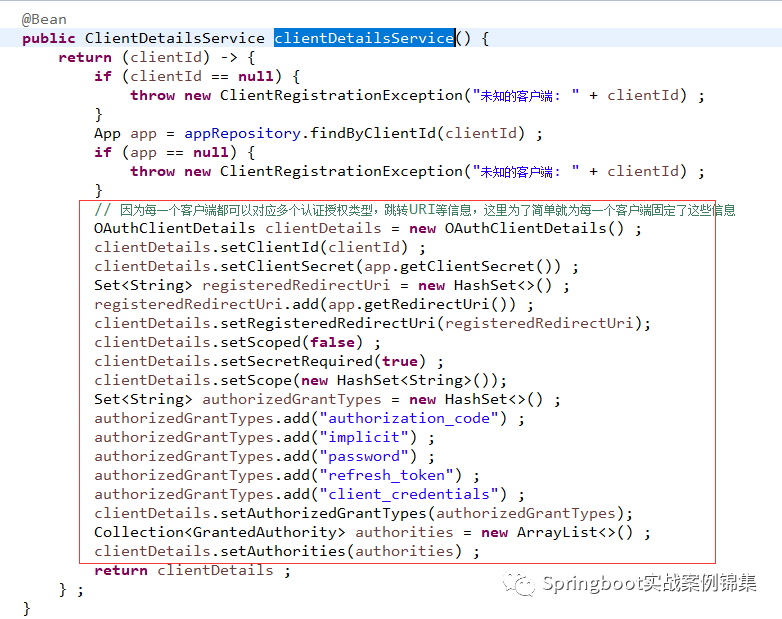 图片
图片
这里就是为了获取当前客户端的所有信息使用。
public class OAuthClientDetails implements ClientDetails,Serializable {
private static final long serialVersionUID = 1L;
private String id ;
private String clientId ;
private boolean secretRequired ;
private String clientSecret ;
private boolean scoped ;
private Set<String> resourceIds ;
private Set<String> scope = new HashSet<>();
private Set<String> authorizedGrantTypes = new HashSet<>();
private Set<String> registeredRedirectUri = new HashSet<>();
private Collection<GrantedAuthority> authorities ;
private boolean autoApprove ;
private Integer accessTokenValiditySeconds ;
private Integer refreshTokenValiditySeconds ;
}- 登录认证类
@Component
public class LoginAuthenticationProvider implements AuthenticationProvider {
@Resource
private UsersRepository usersRepository ;
@Override
public Authentication authenticate(Authentication authentication) throws AuthenticationException {
// 登录用户名
String username = authentication.getName() ;
// 凭证(密码)
Object credentials = authentication.getCredentials() ;
Users user = null ;
try {
user = usersRepository.findByUsernameAndPassword(username, (String) credentials) ;
if (user == null) {
String errorMsg = "错误的用户名或密码" ;
throw new BadCredentialsException(errorMsg) ;
}
} catch (Exception e) {
throw e ;
}
UsernamePasswordAuthenticationToken result = new UsernamePasswordAuthenticationToken(
user, authentication.getCredentials(), Arrays.asList(
new SimpleGrantedAuthority("ROLE_USERS"),
new SimpleGrantedAuthority("ROLE_ACTUATOR")));
result.setDetails(authentication.getDetails());
return result;
}
@Override
public boolean supports(Class<?> authentication) {
return (UsernamePasswordAuthenticationToken.class
.isAssignableFrom(authentication));
}
}- 密码验证
@Component
public class LoginPasswordEncoder implements PasswordEncoder {
@Override
public String encode(CharSequence rawPassword) {
return rawPassword.toString() ;
}
@Override
public boolean matches(CharSequence rawPassword, String encodedPassword) {
return this.encode(rawPassword).equals(encodedPassword) ;
}
}注意:
Users实体类为啥要实现UserDetails?
应该我们在存储token相关信息到redis时需要有对应key的生成方式。
RedisTokenStore.java中有个默认的key生成方式:
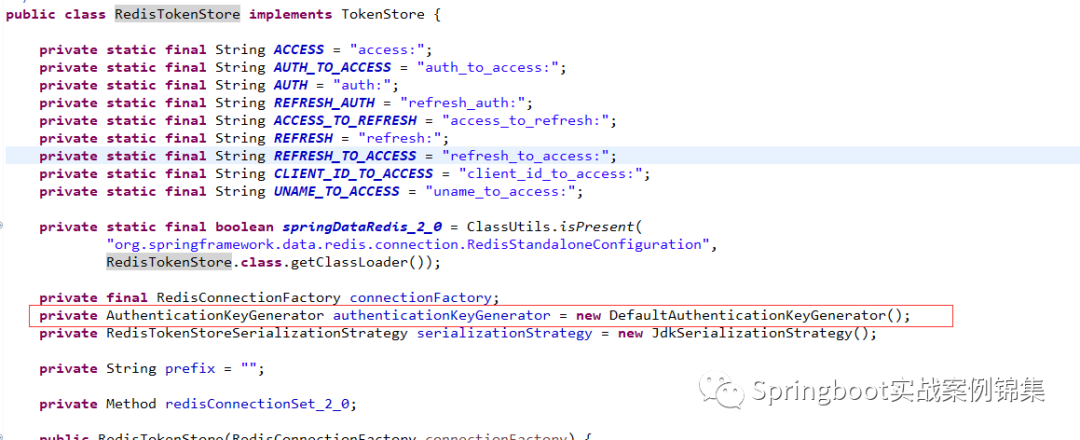 图片
图片
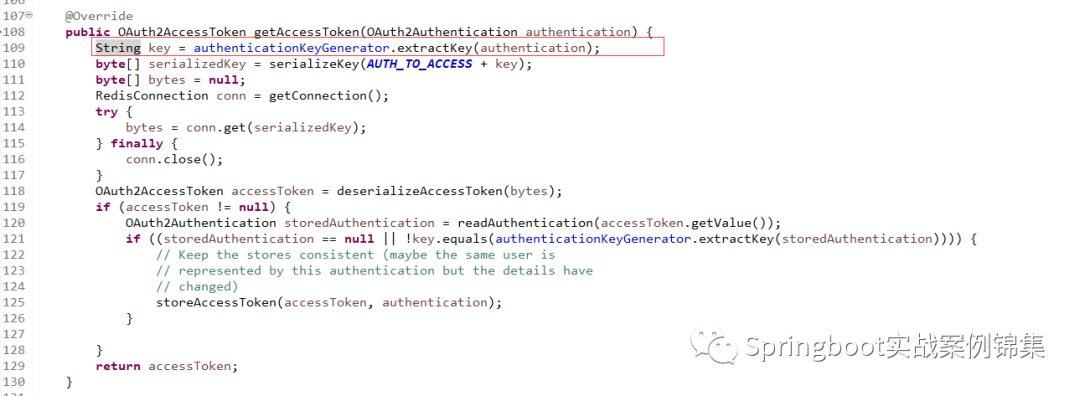 图片
图片
进入上面的方法中:
 图片
图片
进入getName方法中:
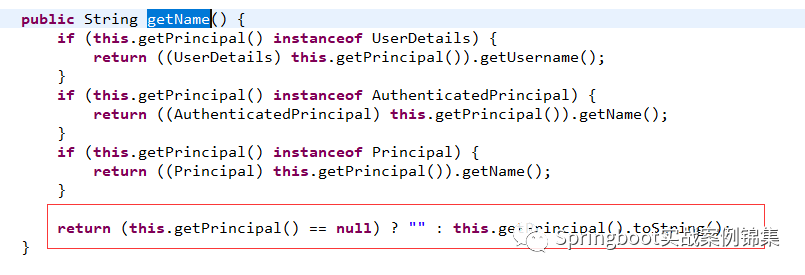 图片
图片
最终它会调用红色框中的代码,这样就出现一个问题,你每次获取token的时候都会生成一个新的token。所以这里我们的Users实体实现了UserDetails接口。
 图片
图片
这里是通过debug查看
到此整合完毕了!
测试:
先造两条数据:
 图片
图片
 图片
图片
- 授权码模式
授权码模式(authorization code)是功能最完整、流程最严密的授权模式。它的特点就是通过客户端的后台服务器,与"服务提供商"的认证服务器进行互动。
 请求地址
请求地址
 图片
图片
访问上面地址后跳转到了登录页面
输入正确的用户名密码后:
 图片
图片
成功后跳到了我们配置的跳转地址,这时候我们就可以根据地址栏的code获取token了:
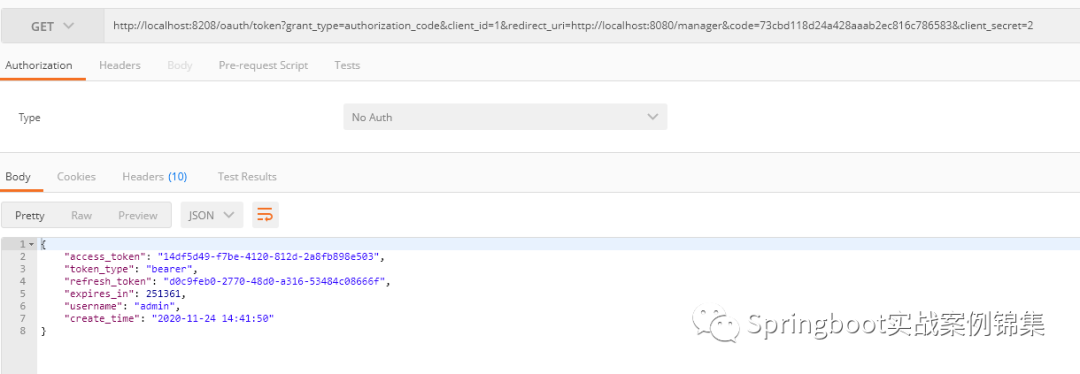 图片
图片
注意:这里的code是一次性的,也就是说如果使用过了就会自动失效。
- 密码模式
密码模式(Resource Owner Password Credentials Grant)中,用户向客户端提供自己的用户名和密码。客户端使用这些信息,向"服务商提供商"索要授权。
在这种模式中,用户必须把自己的密码给客户端,但是客户端不得储存密码。这通常用在用户对客户端高度信任的情况下,比如客户端是操作系统的一部分,或者由一个著名公司出品。而认证服务器只有在其他授权模式无法执行的情况下,才能考虑使用这种模式。

 图片
图片
- 客户端模式
客户端模式(Client Credentials Grant)指客户端以自己的名义,而不是以用户的名义,向"服务提供商"进行认证。严格地说,客户端模式并不属于OAuth框架所要解决的问题。在这种模式中,用户直接向客户端注册,客户端以自己的名义要求"服务提供商"提供服务,其实不存在授权问题。
 图片
图片
- 简化模式
简化模式(implicit grant type)不通过第三方应用程序的服务器,直接在浏览器中向认证服务器申请令牌,跳过了"授权码"这个步骤,因此得名。所有步骤在浏览器中完成,令牌对访问者是可见的,且客户端不需要认证。
 图片
图片
简化模式的流程,这样有助于理解
(A)客户端将用户导向认证服务器。
(B)用户决定是否给予客户端授权。
(C)假设用户给予授权,认证服务器将用户导向客户端指定的"重定向URI",并在URI的Hash部分包含了访问令牌。
(D)浏览器向资源服务器发出请求,其中不包括上一步收到的Hash值。
(E)资源服务器返回一个网页,其中包含的代码可以获取Hash值中的令牌。
(F)浏览器执行上一步获得的脚本,提取出令牌。
(G)浏览器将令牌发给客户端。
- 刷新令牌
如果用户访问的时候,客户端的"访问令牌"过期前,可以申请一个新的访问令牌。
 图片
图片
这里的refresh_token就是在获取token的时候返回的。






































